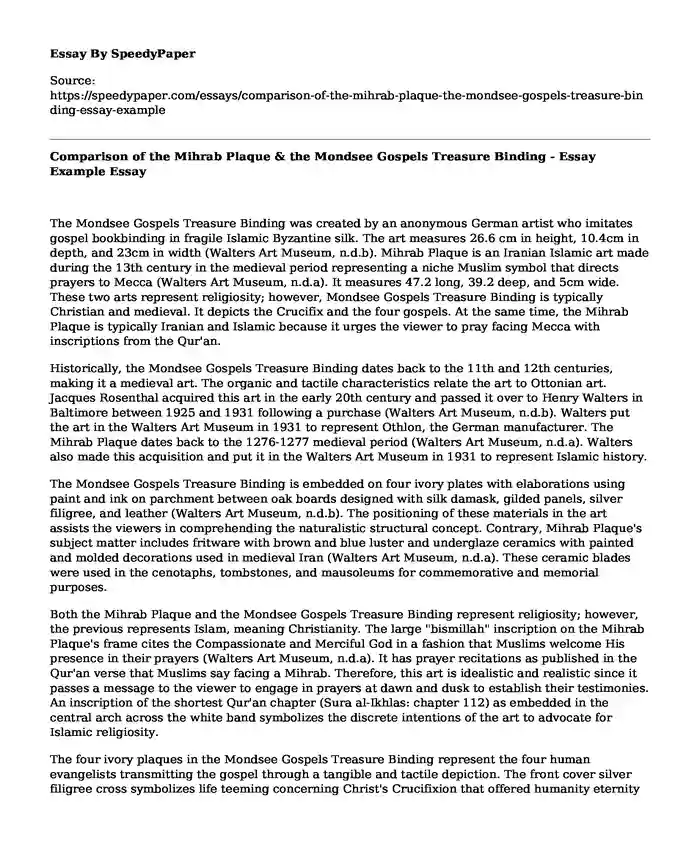
| Essay type: | Compare and contrast |
| Categories: | History Islam Religion |
| Pages: | 3 |
| Wordcount: | 741 words |
The Mondsee Gospels Treasure Binding was created by an anonymous German artist who imitates gospel bookbinding in fragile Islamic Byzantine silk. The art measures 26.6 cm in height, 10.4cm in depth, and 23cm in width (Walters Art Museum, n.d.b). Mihrab Plaque is an Iranian Islamic art made during the 13th century in the medieval period representing a niche Muslim symbol that directs prayers to Mecca (Walters Art Museum, n.d.a). It measures 47.2 long, 39.2 deep, and 5cm wide. These two arts represent religiosity; however, Mondsee Gospels Treasure Binding is typically Christian and medieval. It depicts the Crucifix and the four gospels. At the same time, the Mihrab Plaque is typically Iranian and Islamic because it urges the viewer to pray facing Mecca with inscriptions from the Qur'an.
Historically, the Mondsee Gospels Treasure Binding dates back to the 11th and 12th centuries, making it a medieval art. The organic and tactile characteristics relate the art to Ottonian art. Jacques Rosenthal acquired this art in the early 20th century and passed it over to Henry Walters in Baltimore between 1925 and 1931 following a purchase (Walters Art Museum, n.d.b). Walters put the art in the Walters Art Museum in 1931 to represent Othlon, the German manufacturer. The Mihrab Plaque dates back to the 1276-1277 medieval period (Walters Art Museum, n.d.a). Walters also made this acquisition and put it in the Walters Art Museum in 1931 to represent Islamic history.
The Mondsee Gospels Treasure Binding is embedded on four ivory plates with elaborations using paint and ink on parchment between oak boards designed with silk damask, gilded panels, silver filigree, and leather (Walters Art Museum, n.d.b). The positioning of these materials in the art assists the viewers in comprehending the naturalistic structural concept. Contrary, Mihrab Plaque's subject matter includes fritware with brown and blue luster and underglaze ceramics with painted and molded decorations used in medieval Iran (Walters Art Museum, n.d.a). These ceramic blades were used in the cenotaphs, tombstones, and mausoleums for commemorative and memorial purposes.
Both the Mihrab Plaque and the Mondsee Gospels Treasure Binding represent religiosity; however, the previous represents Islam, meaning Christianity. The large "bismillah" inscription on the Mihrab Plaque's frame cites the Compassionate and Merciful God in a fashion that Muslims welcome His presence in their prayers (Walters Art Museum, n.d.a). It has prayer recitations as published in the Qur'an verse that Muslims say facing a Mihrab. Therefore, this art is idealistic and realistic since it passes a message to the viewer to engage in prayers at dawn and dusk to establish their testimonies. An inscription of the shortest Qur'an chapter (Sura al-Ikhlas: chapter 112) as embedded in the central arch across the white band symbolizes the discrete intentions of the art to advocate for Islamic religiosity.
The four ivory plaques in the Mondsee Gospels Treasure Binding represent the four human evangelists transmitting the gospel through a tangible and tactile depiction. The front cover silver filigree cross symbolizes life teeming concerning Christ's Crucifixion that offered humanity eternity (Walters Art Museum, n.d.b). The cross's central region has a golden leaf with a sizeable colorless rock crystal that protects the Crucifix and symbolizes purity. The transparency in the crystal represents frozen water that invokes concerns about Christ's dual nature. The liquid and solid depictions of the rock convey how Christ emancipates in flesh and spirit. The flat backside of the Crucifixion allows it to rest on the Alter while the gilded silver engraves how St. Michael slays a dragon (Walters Art Museum, n.d.b). This art portrays the message that there is life after death, and Christians should follow Christ's teaching and embrace the protection from St. Michael.
Conclusion
In conclusion, the Mondsee Gospels Treasure Binding and the Mihrab Plaque symbolize religiosity, Christianity, and Islam, respectively. The two arts' main difference is their history from Germany and Iran, respectively; however, Walters acquired them both and put them in one museum. The artworks also vary in size, materials, and inscriptions such that the previous has delicate parchments with silver filigree, leather, gilded panels, silk damask, gold leaf, and rock crystal. At the same time, the latter is purely ceramic with fritware, lusterware, and underglaze decorations.
References
Walters Art Museum. (n.d.a) "Mihrab" Plaque. https://art.thewalters.org/detail/29876/mihrab-plaque/.
Walters Art Museum. (n.d.b) The Mondsee Gospels and Treasure Binding with the Evangelists and Crucifixion. https://art.thewalters.org/detail/17493/the-mondsee-gospels-and-treasure-binding-with-the-evangelists-and-crucifixion/.
Cite this page
Comparison of the Mihrab Plaque & the Mondsee Gospels Treasure Binding - Essay Example. (2024, Jan 28). Retrieved from https://speedypaper.net/essays/comparison-of-the-mihrab-plaque-the-mondsee-gospels-treasure-binding-essay-example
Request Removal
If you are the original author of this essay and no longer wish to have it published on the SpeedyPaper website, please click below to request its removal:
- Free Paper Example: Biographical Sketch of Augustine of Hippo (354-430)
- The Church on Cultural Divide, Free Essay for You
- The Mediterranean World Since 1500 - Paper Example
- Essay Sample on Significance of John F. Kennedy
- Free Essay Example. Ethical Dilemma: Euthanasia
- What Happened After the War - Free Essay Example
- Paper Example. The Civil Rights Movements History
Popular categories




